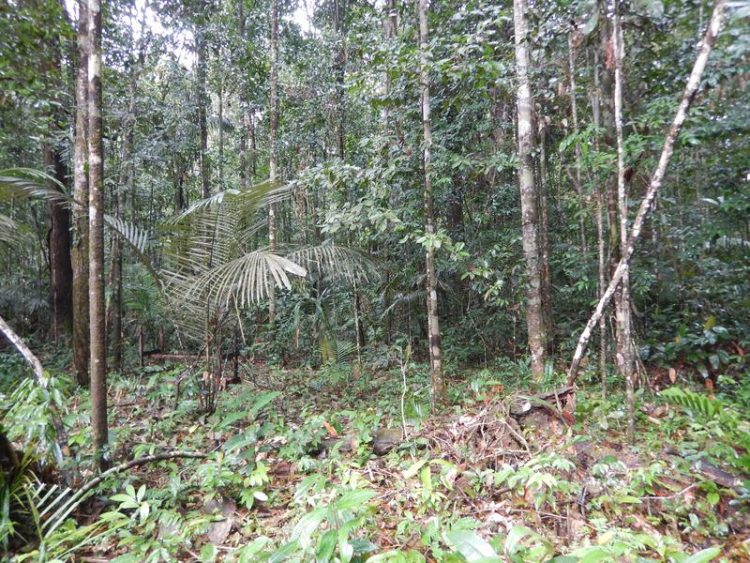Surprise from the jungle soil

The trees of the Amazon rainforest emit huge amounts of volatile substances. Photo: Cybelli Barbosa
The Amazon rainforest is the largest forest on earth. Its trees emit huge amounts of volatile substances that influence the chemical composition of the air. Some of these substances are the so-called sesquiterpenes, very reactive chemicals that can rapidly consume ozone. Until recently scientists studying the air composition in forests were primarily focused on trees and plants.
An international research team has now revealed, that the soil emissions of sesquiterpenes can be, under certain conditions, just as strong as those from the canopy. The molecules are produced by microorganisms in the soil.
This discovery shows that the emissions from soil to air are an important component of the Amazonian ecosystem that had been previously overlooked. The study results have recently been published in the journal Nature Communications.
“In previous studies, we found an ozone gradient in the Amazon forest with low levels near the soil. We thus suspected that we were missing an important source of reactive molecules removing the ozone,” said Jonathan Williams, group leader at the Max Planck Institute for Chemistry.
Sesquiterpenes react rapidly with ozone and can therefore impact the self-cleaning capacity of the atmosphere – a chemical process, whereby pollutants are removed from the air. The soil emissions are responsible for the depletion of about 50 percent of the ozone close to the forest floor which slows down the cleaning processes and can help pollinating insects find flowers via their scent.
The scientists first collected soil samples from several different sites in the Amazon jungle, most of them from the Amazon Tall Tower Observatory (ATTO), representing pristine Amazonian forest. Under controlled laboratory conditions, they then added water to simulate rain, and watched for volatile emissions as the soil dried out. As the drying progressed, conditions in the soil changed to suit different communities of soil microbes, each of which emitted different characteristic chemicals including sesquiterpenes.
“We found very similar patterns of sesquiterpene emissions and microbial activity in the soil,” says Thomas Behrendt, soil scientist at the Max Planck Institute for Biogeochemistry in Jena. Based on the experimental results, Efstratios Bourtsoukidis, an atmospheric chemist at the Max Planck Institute for Chemistry, developed a precise numerical model to predict the fluxes of sesquiterpenes between the soil and the atmosphere. When simulating the daily fluxes from a very common tropical soil and the canopy over a period of two years, Bourtsoukidis observed that sesquiterpene emissions from the soils in the dry season were at certain times as strong as canopy emissions.
The study results show how important the connection between soil microbes and atmospheric chemistry is.
Dr. Jonathan Williams
Max Planck Institute for Chemistry, Mainz, Germany
Telephone: +49-6131-305 4500
Email: jonathan.williams@mpic.de
Dr. Thomas Behrendt
Max- Planck Institute for Biogeochemistry, Jena, Germany
Telephone: +49-3641 57-60 6105
Email: tbehr@bgc-jena.mpg.de
Strong sesquiterpene emissions from Amazonian soils
E. Bourtsoukidis, T. Behrendt, A.M. Yañez-Serrano, H. Hellén, E. Diamantopoulos, E. Catão, K. Ashworth, A. Pozzer, C.A. Quesada, D.L. Martins, M. Sá, A. Araujo, J. Brito, P. Artaxo, J. Kesselmeier, J. Lelieveld & J. Williams
Nature Communications, 8 June 2018
DOI: 10.1038/s41467-018-04658-y
https://www.nature.com/articles/s41467-018-04658-y
Media Contact
More Information:
http://www.mpic.de/All latest news from the category: Earth Sciences
Earth Sciences (also referred to as Geosciences), which deals with basic issues surrounding our planet, plays a vital role in the area of energy and raw materials supply.
Earth Sciences comprises subjects such as geology, geography, geological informatics, paleontology, mineralogy, petrography, crystallography, geophysics, geodesy, glaciology, cartography, photogrammetry, meteorology and seismology, early-warning systems, earthquake research and polar research.
Newest articles

Properties of new materials for microchips
… can now be measured well. Reseachers of Delft University of Technology demonstrated measuring performance properties of ultrathin silicon membranes. Making ever smaller and more powerful chips requires new ultrathin…

Floating solar’s potential
… to support sustainable development by addressing climate, water, and energy goals holistically. A new study published this week in Nature Energy raises the potential for floating solar photovoltaics (FPV)…

Skyrmions move at record speeds
… a step towards the computing of the future. An international research team led by scientists from the CNRS1 has discovered that the magnetic nanobubbles2 known as skyrmions can be…




















